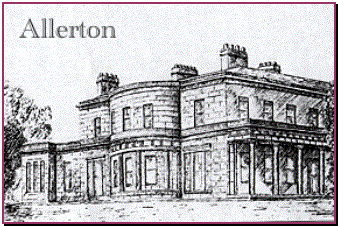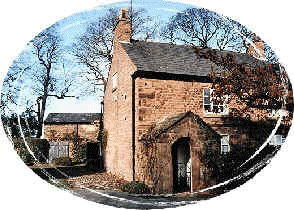 |
 |
Allerton

It has been said that Allerton Golf Course is
one of the oldest municipal golf courses in the country which is probably quite
right given that it began during the Tertiary Period, survived several Ice Ages
and has taken over 240 million years to get here.
Allerton Golf course was once a desert. The many metres of
fossilised sand dunes testify eloquently to the fact. The red sandstone  layers
of sedimentary rock are ancient grains of sand, compressed layer by layer over
millenia and welded
together by silica to form an attractive and easily worked stone. Woolton
quarry, a stone's throw away, supplied much of the stone for Liverpool Anglican
Cathedral and most of the more attractive buildings in the area are of local red
sandstone. Animal fossils are rare in sandstone ----- the shifting sand often
covered any tracks and none of any description have ever come to light on
Allerton .
layers
of sedimentary rock are ancient grains of sand, compressed layer by layer over
millenia and welded
together by silica to form an attractive and easily worked stone. Woolton
quarry, a stone's throw away, supplied much of the stone for Liverpool Anglican
Cathedral and most of the more attractive buildings in the area are of local red
sandstone. Animal fossils are rare in sandstone ----- the shifting sand often
covered any tracks and none of any description have ever come to light on
Allerton .
There are exceptions such as the footprints of an ancient
Chimotherium which was excavated from Hilbre island and can now be seen in
Liverpool Museum. These tracks were also 240 million years old but they were in
all probability formed in mud. Allerton's sandstone hillock with its thin skin
of top-soil is the reason why Allerton is playable when many other courses are
closed ----- it drains quickly, warms up early in the year and cools slowly in
Autumn. The severely compacted ground is also why the fairways could never be
described as verdant and when cockchafers and garden chafers are prevalent
throughout Woolton in plagues of Biblical proportions it is the reason why
Allerton remains relatively unscathed. Put a spade in at random and it is
reasonable to assume that at one foot depth your arm will jar from wrist to
shoulder which is why tree plantings are never attempted without the aid of a
mechanical digger.
How any trees live in the rocky ground is yet another
testament, if one is needed, to the tenacity and insistence of plant life to
grow and reproduce and most of the flora on the sandstone not only grasps at
life but flourishes in the most difficult of conditions. The occasional tree bent in the wind or suddenly toppled over for no particular reason has usually
hit an impenetrable sandstone shelf several metres down but a few yards away its
fellow tree will thrive on roots entering into fissures the fallen tree never
found. Layers of clay ground by glaciers are the source
of sustenance that all the deep-rooted plants on the plateau search for,
breaking through solid rock with carbon-tipped roots.
bent in the wind or suddenly toppled over for no particular reason has usually
hit an impenetrable sandstone shelf several metres down but a few yards away its
fellow tree will thrive on roots entering into fissures the fallen tree never
found. Layers of clay ground by glaciers are the source
of sustenance that all the deep-rooted plants on the plateau search for,
breaking through solid rock with carbon-tipped roots.
It is not essential to know all these things and many pass
through the golf course without a thought in that direction but when the
Fletcher brothers, of the Biblical Christian names Jacob and Caleb, began to
build their home on Allerton they may have been astounded to know they were
flying in the face of The Old Testament and building their house upon sand.
But that is a few years in the future ----
The story began with Jacob and Caleb's father { who was
also Jacob Fletcher } from Broughton in Cumberland who arrived in Liverpool in
1750 . Jacob was in the very lucrative trade of privateering and his name and
ship actions appear at regular intervals in the shipping records of Liverpool.
Shipping records in England are very meticulous and for this reason Jacob  Fletcher
the elder is known more than his two sons.
Fletcher
the elder is known more than his two sons.
In 1778, George the Third was beginning his bouts of illness and the American
War of Independence had begun when Jacob sailed into the Mersey in command of
the aptly named "Catcher" trailing a captured French vessel containing
130,000 pounds of sugar, 115 barrels of coffee, 7 barrels of indigo and 12 bales
of cotton.
His name appears again in 1794 when he is in charge of the "
Elizabeth" arriving in Jamaica after fighting off two 14 and 16 gun French
ships on the way.
Again in the " Elizabeth" and again off Jamaica, Jacob is to be found
fighting yet more French ships in January, 1786. The fighting was fiercer than
ever with the " Elizabeth" making landfall minus thirty of his crew,
killed in action.
Accolades must have been difficult to come by in those hardy days as it was only
after the latter action that Jacob's London underwriters thought to show their
appreciation of his efforts with a silver plate valued at 100 guineas, inscribed
and hallmarked 1786.
Privateering was an extraordinary occupation in those days
being somewhere between merchantman and pirate. The chief occupation of a privateer was to capture any ship deemed to be an enemy of
England, strip it of all goods and sell it as a prize. The government turned a
blind eye to the privateers with the view that they were aiding the Royal Navy
but the privateers were not averse to raiding British ships in times of
desperation.
occupation of a privateer was to capture any ship deemed to be an enemy of
England, strip it of all goods and sell it as a prize. The government turned a
blind eye to the privateers with the view that they were aiding the Royal Navy
but the privateers were not averse to raiding British ships in times of
desperation.
There were fortunes to be earned in the privateering trade and
unsurprisingly there was never a short of volunteers at a time when the Royal
navy constantly had to resort to the press-gang for their crews. Jacob Fletcher
was just one of many sailing out of Liverpool, terrorising any ships which
crossed his path and giving the city the louche reputation which still adheres
to this day.
There were fortunes to be made in Liverpool in those days and ship captains were not slow to make their homes in the prestigious houses in Canning Street, Gambier Terrace, Upper Parliament Street et al ------close to the docks in luxurious homes. Jacob chose to make his home among the Georgian terraces of Duke Street. He was probably on nodding terms with John Bellingham, the killer of Spencer Percival, possibly tipped his hat to a very young Felicia Hemans who was just beginning her career writing poetry and he may have known of Sarah Biffen, the armless court-painter. The first mention of his sons is when Jacob is recorded as living at Richmond Row and making his way as a merchant. Caleb joined him in his new ventures while the third son was called Joseph
Jacob junior must have been as su ccessful as a merchant as
his father was as seaman and in the purchase of 150 acres of land fronting
Allerton Road and once belonging to the vast Hardman domain, he joined the elite
band of estate owners out in the sylvain suburbs of the city. Many
of the manor houses and country estates surrounding the city centre were founded
on sea-going ventures --- Calderstones and Sudley immediately come to mind.
ccessful as a merchant as
his father was as seaman and in the purchase of 150 acres of land fronting
Allerton Road and once belonging to the vast Hardman domain, he joined the elite
band of estate owners out in the sylvain suburbs of the city. Many
of the manor houses and country estates surrounding the city centre were founded
on sea-going ventures --- Calderstones and Sudley immediately come to mind.
Once
they had chosen their domain Jacob and Caleb turned their attention to a mansion
worthy of its setting and they employed Harrisson of Chester having been
impressed with his plans for the spire at St. Nicholas Church. The house was no
sooner finished than it burnt down.
Undaunted, the brothers built another mansion above the
ruins of the first and while The Battle of Waterloo { 1815 } was taking its
course, Jacob and Caleb were moving into their new home which they named "Allerton".
The mansion houses and the land surrounding them were all very similar in those
days. The mansion itself would be fronted by a large lawn for picnics and
croquet and there was invariably a path to the front door for horse and carriage
which would be semi-circular so there would never be a need to back the
carriages up when leaving. Beyond the lawns would be sheep or cattle grazing and
the Ha-Ha was almost obligatory. The Victorian gardeners had a penchant for
building roc k
features alongside the driveways and walkways. The most pronounced of these is
at Childwall woods where a deep cutting has been chiselled through the sandstone
to allow carriage access --- on damp and foggy Autumn evenings it's not too
difficult to envisage a coach and four pelting along the loamy pathway en -
route to the great house. All these features can still be seen at Allerton
although they are slowly crumbling ---- the lawns are now the putting green and
the Ha-Ha hidden by the rhododendrons and balsams is still intact.
k
features alongside the driveways and walkways. The most pronounced of these is
at Childwall woods where a deep cutting has been chiselled through the sandstone
to allow carriage access --- on damp and foggy Autumn evenings it's not too
difficult to envisage a coach and four pelting along the loamy pathway en -
route to the great house. All these features can still be seen at Allerton
although they are slowly crumbling ---- the lawns are now the putting green and
the Ha-Ha hidden by the rhododendrons and balsams is still intact.
There's a plaque on the front of the house on the drive up
from Menlove Avenue which says
J H Fletcher
1740
At first it seems to be obviously referring to Jacob but the carved sandstone sign is misleading because
the house was there a decade before the first Jacob arrived in Liverpool. The
adjoining houses and apartments also have a sign saying Fletchers Barn but these
also were there far before Jacob sailed on his first ship. Fletcher
himself said that the sign referred to the previous owner J.H.Tarleton who owned
the land in 1740 but present thinking holds that the T has been worn down from a
J and at that time it was customary to place the surname in the middle and the
Christian names on either side ----- which then makes the sign mean John and
James Hardman, who owned the adjoining Allerton Hall and estates surrounding.
The courtyard between
the two has beneath ground a vast cistern which ingeniously catches the run-off
from the adjoining roof tops with a series of pipes. A sandstone trough at one
end of the cistern at o ne
time had a hand pump which kept the trough full of fresh water for the horses.
The cistern is in perfect condition and the addition of the missing pump would
without doubt see it working as well as it did 200 years ago.
ne
time had a hand pump which kept the trough full of fresh water for the horses.
The cistern is in perfect condition and the addition of the missing pump would
without doubt see it working as well as it did 200 years ago.
Most estates of that era had a kitchen garden surrounded by hollow walls with
fireplaces here and there along their length. The finest example of this is the
Old English garden at Calderstones. In the Winter, fires would be lit in the
recesses and the resulting smoke would travel through the cavities in the walls
warming the peaches and other tender plants.
The kitchen garden at Allerton was
typically a walled rectangle situated where17th tee now stands. It was turned
into grass tennis courts prior to its final incarnation as a rose-garden until
it was sadly demolished circa 1985. The statue of Mercury went missing at
this time.
So, Jacob and Caleb finally settled down as country squires, and while many of
Liverpool's inhabitants lived in fetid courts and grinding poverty, they enjoyed
an existence that others could only dream about. The brothers were both sporting
men and paintings of well known racehorses of the day hung upon the walls of the
great house. Two of these were "Barefoot" and "Memnon",
St.L eger
winners in 1823 and 1825, and legend has it that the brothers brought the same
horses to Allerton in payment of a debt.
eger
winners in 1823 and 1825, and legend has it that the brothers brought the same
horses to Allerton in payment of a debt.
Jacob and Caleb were also active on the hunt scene and managed The Liverpool
Hunt, the kennels of which re-located from Richmond Row off Byrom St to Bank
Hall and eventually to a house called "Greenhill"on the corner of
Allerton road and Greenhill Road which is now one of the most popular pubs in
the area and would have undoubtedly met with Jacob and Caleb's enthusiastic
approval.
There is a story that the old road which ran from the gable
end of the mansion house across Woolton road and plante d
on each side with a row of beech trees was built by the Fletcher family but this
is probably another blurring of times and dates as the road was there in 1768
and was in all probability there when John and James Hardman bought
Allerton Hall from the Perceval family in 1736. The road which was lined
with beech trees began at Allerton Hall, passed the windmill, through Allerton
Priory and onto the obelisk.
d
on each side with a row of beech trees was built by the Fletcher family but this
is probably another blurring of times and dates as the road was there in 1768
and was in all probability there when John and James Hardman bought
Allerton Hall from the Perceval family in 1736. The road which was lined
with beech trees began at Allerton Hall, passed the windmill, through Allerton
Priory and onto the obelisk.
Most of the trees are fallen but here and there is a beech which could easily be
of that age and a part of the original pathway. The house has been called
"Grove House" after this road.
It has also been called " Obelisk House" after
the sandstone obelisk adjacent to the house. The obelisk is exactly five miles from Liverpool
Town Hall and the corners face the four corners of the compass. This is yet
another feature of the land which pre-dates the Fletcher's purchase, with the
earliest record of the obelisk being1768 and presumably a folly dreamed up by
the Hardman family.
obelisk adjacent to the house. The obelisk is exactly five miles from Liverpool
Town Hall and the corners face the four corners of the compass. This is yet
another feature of the land which pre-dates the Fletcher's purchase, with the
earliest record of the obelisk being1768 and presumably a folly dreamed up by
the Hardman family.
Unfortunately, Jacob and Caleb's descendants were no
respecters of historical monuments and Captain Lionel Fletcher and Lt. Colonel
Lionel Fletcher, a famed international rifle-shot of his day, spent rainy days
firing at the copper ball which sat on the top of the obelisk, riddling it with
bullets and pock marking the sandstone slabs.
The halcyon days of the Fletcher family came to an end when
Allerton joined so many other private estates throughout the city and in 1923
was ceded to the City of Liverpool in perpetuity. The 9 hole course was built in
August of that year, closely followed by the 18 hole course in the October.
The house itself provided a fine club-house and refreshment rooms and the people
of Liverpool finally came to benefit from Jacob Fletcher's piratical nature and
are reaping the benefits still.
During the Second World War there was a battery situated on
the top of the golf course. The German planes would follow the river as a
landmark just as planes still do today but in the 1940's the passage would have
been a little more difficult. Old Wooltonians still tell of watching dogfig hts
over the Mersey estuary and a local legend has it that one plane came down and
ploughed into the 11th fairway where it lies to this day, 20 foot underground.
Whatever, the truth of this tale
which sounds like an urban myth, there's no doubt about the gap in the row
of terraces along Vale Road at the corner of Cobden street which testifies to an
errant bomb falling.
hts
over the Mersey estuary and a local legend has it that one plane came down and
ploughed into the 11th fairway where it lies to this day, 20 foot underground.
Whatever, the truth of this tale
which sounds like an urban myth, there's no doubt about the gap in the row
of terraces along Vale Road at the corner of Cobden street which testifies to an
errant bomb falling.
Many of the city municipal departments were moved into
Allerton during the war years including a section of the military and at one
stage the city archives were housed in the cellars until it was found that damp
was destroying them more efficiently than the Germans ever could. It was
therefore ironic that having escaped disaster for most of the war the golf
professional smelled smoke in on of the rooms in November 1944 too late to save
the house from burning down. He did however save several valuable
Kirkby Golf Course and Bowring Park Golf Course were ploughed up during the war
to grow vegetables and it wasn't until the 1950's that they were returned to
their former status. Allerton escaped this fate, again due to it's unusual
topography, and kept the flag flying { or 18 flags in this case } for the game
of golf.
The facade is all that remains of the splendour that was
Allerton and despite it being a listed building the Woolton version of bonsai
trees populating the top course of brick are slowly disintegrating the mortar.
It's just a matter of time before the tree roots bring down the very structure
which is sustaining them so well.
There are still old greensmen who worked on Allerton who
will tell you that right up until the mid-fifties the greens were mown using
push mowers such as the Ransomes Zephyr taking up to an hour to cut a single
green. The Zephyr evolved into the Autocertes which was essentially a Zephyr
with an engine and the work was easier but still required a lot of walking.
Greens machines now are state-of-the art ride-ons taking half a day effortlessly
to cut all greens.
The first Golf Professional to oversee the course
was a certain Mr Gregg who retained the post from 1923 until 1940 when William
Large took over. At that time the Golf Professional resided in the mansion house
itself and it was William Large who called out the fire brigade on the night of
November 1944 when the house was gutted by fire. William Large was followed by
his son Jim Large and Barry Large followed his father into the post maintaining
a dynasty which retains still after 65 years.
The old "Allerton" glimpsed through the snow-covered branches.
-----------------------------------